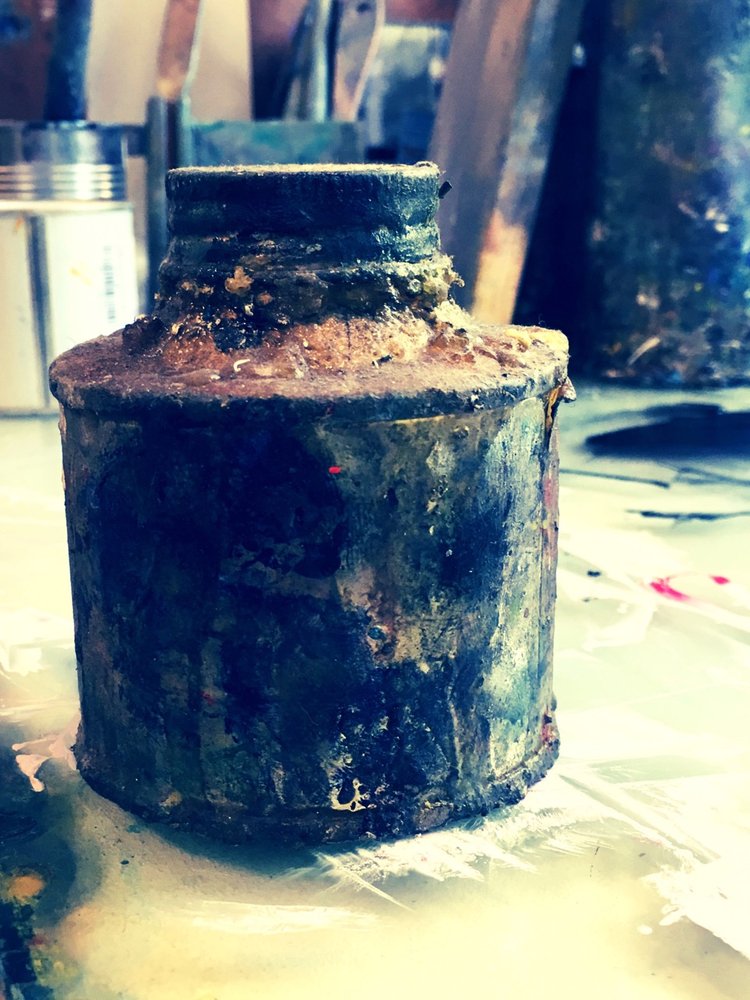Notes on Abstraction
By Jonathan S. Hooper
Painting, art more generally, is a form of dialogue. In this regard it must engage the viewer in a conversation with the painter and the ideas that inspire his work. More than this art is an invitation not only to converse but also to imagine.
Abstract paintings can perhaps fit the Socratic method; they can set up a form of cooperative argumentative dialogue. This dialogue is not just between the painter and the viewer it can also be an internal process through which the viewer scrutinises his or her own beliefs; an internal dialectic that draws out the viewer's ideas and underlying presumptions. In its rejection of obvious narrative- by avoiding familiar, recognisable or representational reference points- abstraction lays down a challenge to the imagination and a rebuke to passivity.
Abstract paintings use ambiguity in order to disrupt. They confront us with our prejudices and predispositions and in doing so they set up a conversational tension. The viewer is invited to consider intention but is also encouraged to reside in the possibility that “ meaning ” is secondary to “value”; where “value” is vested in some elusive feeling about, or experience of, pictorial balance. For all that a painting can mean , its value is substantiated by its ability to harmonise form and colour, to create a balanced and accessible composition.
In my practice, although I largely reject direct representation, I do use grids as a balancing framework. Grids are unquestionably familiar. They exist in all aspects of our physical and spatial environment. Grids allude to a more formal mapping of landscape; the organisation of land, sea and air perhaps or the setting out of pathways, field patterns, geological areas and strata. The built environment is determinedly contrived around grids and linear structures.
In addition to this materialist interpretation grids can be described by Cartesian coordinates, which are in turn an abstraction. With this association in mind abstract paintings might be considered to be a graphical attempt to resolve a more dualistic relationship with landscape; to find balance between the physical and the metaphysical; landscape and memory perhaps.
I use grids for deciphering my relationship with landscape; landscape reimagined as an experiential matrix perhaps. For all their apparent spontaneity these paintings are tethered to an idea and this idea is first described by an underlying framework or structure. [Abstraction is neither automatic nor spontaneous. There are of course moments of unconscious development, but this can only be sustained within the context of something considered; an idea or concept. [ All Art is conceptual: discuss]]
Whether or not we are consciously aware of their presence, grids (formal or informal) help us to rationalise and structure our understanding of 2 and 3-Dimensional space. For all their underlying "x/y-ness" however the structure of these paintings is disrupted by the essential nature of the mark making and the tools that apply the accumulating layers of paint. This can be inadvertent.
The rectilinear structure of the paintings can also be more wilfully disrupted by the use of arcs and angled vectors of paint and scoring. These marks serve to challenge pictorial preconceptions, leading the eye away from the more established conventions for reading the surface of a painting. These rebellious marks can be considered to describe transience; pathways etched into the landscape; objects passing through the field of vision; the progression of waves; the movement of time: the indiscernible processes of change.
Abstract paintings should seek out the essential qualities that define our exterior space, freed as they are from the constraints of literalism or direct representation. In this regard they can perhaps be considered to be “mind maps”, coalescing the physical and the experiential nature of landscape. Maps that combine what we see with what we sense and imagine.
In a metaphysical sense gridlines are an affirmation of the painting’s association with landscape; landscape, in its broadest definition, being the matrix in which we live out all of our experiences. Gridlines are also simply construction aids; the scaffolding or armature around which the painting is constructed, providing the painting space with structural rigidity, balance and coherency. They are also a response to my own need to find order in the infinite realm of possibility.
The physical nature of paint, the tenacity of its colour and texture, allows the memory of previous marks and layers to echo through successive applications. These memories might be only partially revealed as the accumulating layers are scraped back and gouged or they may modify the texture and colour of the paint that is laid down on top of them. Incomplete as these memories may be, they are perhaps an allegory for transition, for the fugitive imperfection of one's own memory or perhaps the development of landscape itself.
The point would seem to be that abstract paintings are less representations of space than they are representations of the experience of space. The materiality of the paint then becomes an analogue through which this experience of landscape, and its resulting incitement to the imagination, can be signified.

